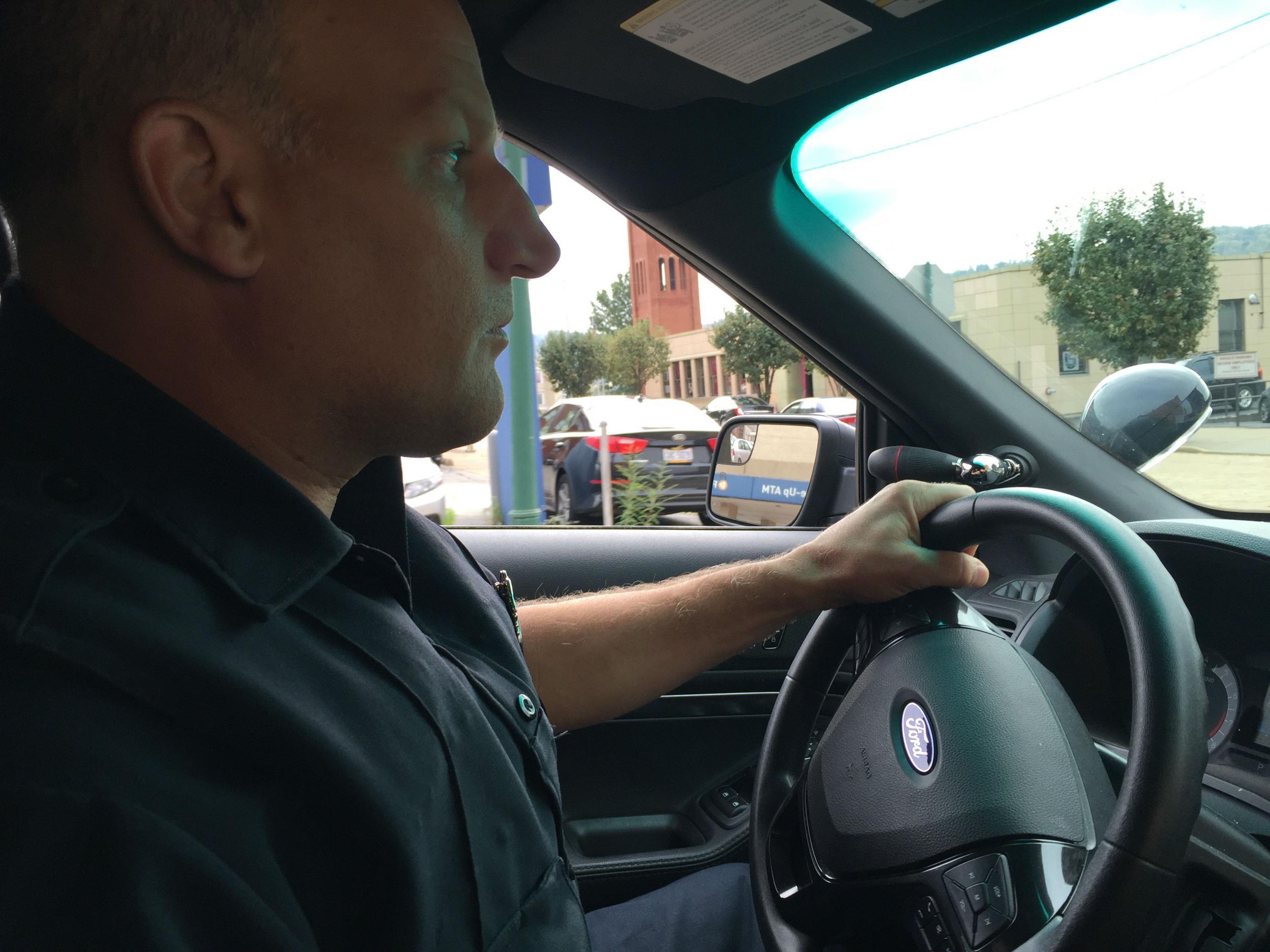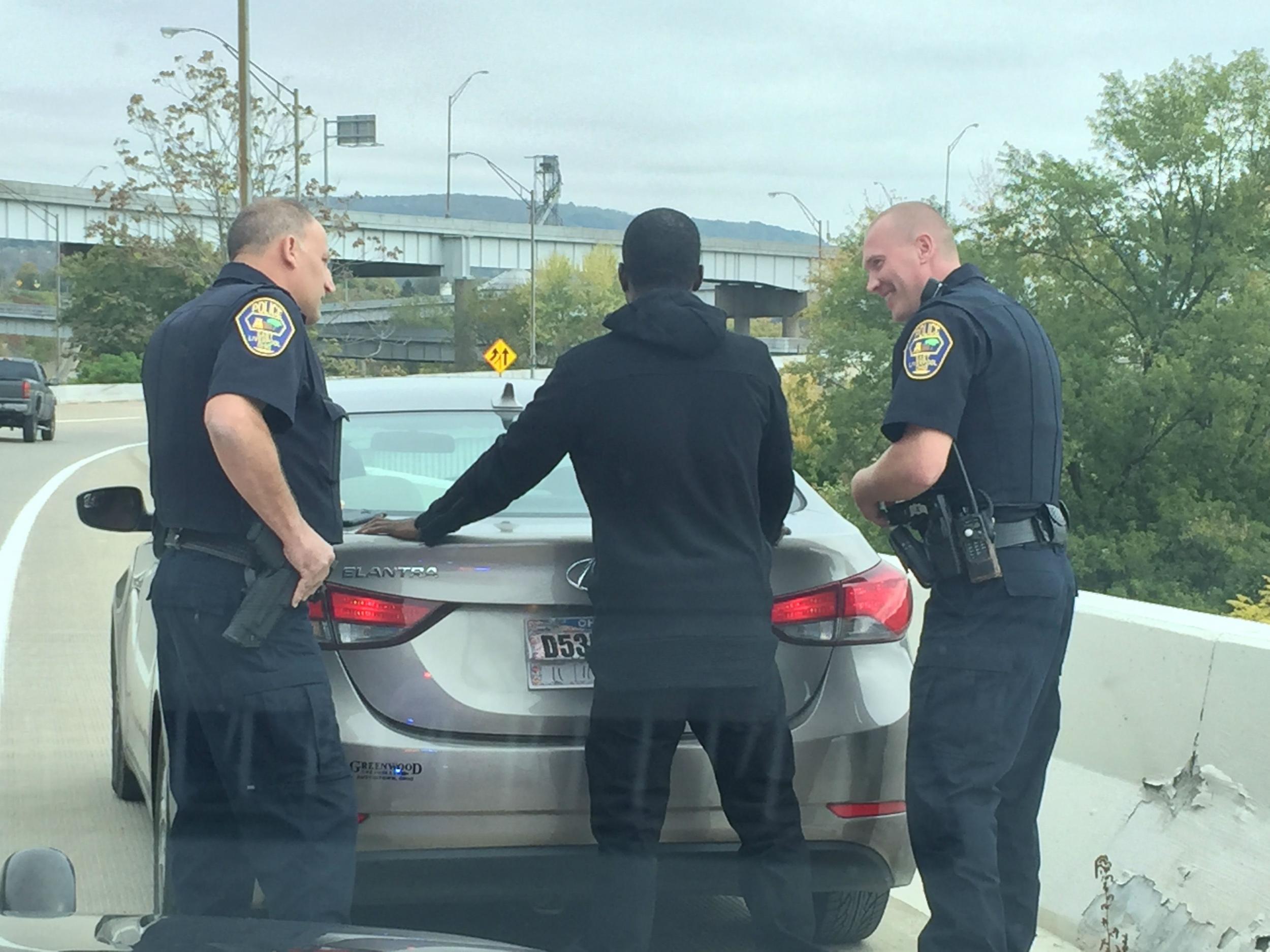The inside story of the heroin overdose photograph that shocked the world
The Independent joined a ‘ride along’ with the Ohio officer who took the image

When patrolman Fred Flati arrived at the stationary vehicle on St Clair Avenue, he assumed the couple in the front were dead. In the rear seat, he caught the flashing eyes of a young boy.
“You can’t believe what you’re seeing,” he said, recalling the incident. “Two people are dead, and they’re sitting in their car seats. It’s painful looking at that little boy’s eyes.”
As it was, the couple were still alive, and their lives were saved by medics who revived them with Narcan, a spray designed to bring around victims of heroin overdoses. The little boy was taken into the care of social services, and then placed with a family member.

The incident may have remained within the confines of the Ohio city of East Liverpool but for a photograph of the scene that Officer Flati clicked with his Samsung Galaxy phone. After the city’s police department took the decision to post that photograph on its Facebook page, the startling, painful image quickly went viral.
The police said they uploaded the image to force people to address what they believe is nothing less than an epidemic tearing at the fabric of their community and countless others across the nation.
They say the problem of heroin addiction had become deadlier in recent years, as a result of the presence of additives such as fentanyl and carfentanyl. Fentanyl is a super-potent drug, usually used in treating cancer patients, while carfentanyl is used to tranquilise large animals, such as elephants.
Fentanyl is 40 time stronger than heroin; carfentanyl 100 time stronger. Experts say that a single grain of the latter, no bigger than a speck of salt, is enough to kill someone with no resistance.
Yet the move to post the photograph was also controversial; some said the decision to post the image without even the face of the little boy being pixelated, was exploitative and unethical.
Meanwhile, the family of the man in the photograph, James Acord, have claimed that he was not a drug user and said police had no right to post the image.
The image was taken on the afternoon of September 6, after another officer, Kevin Thompson, reported following a dark coloured Ford Explorer with registration plates from West Virginia. The vehicle slowly came to a halt.
“I made contact with the driver who was later identified as James Acord. I noted his head bobbing back and forth,” Officer Thompson wrote in his report, later noting that the man passed out.
Police said they thought hard before posting the image. “Sometimes the truth hurts,” said Brian Allen, the city’s safety officer. “It made people see the truth.”
Mr Allen and Chief John Lane, the head of the police department, said they believed East Liverpool was a “Trump town”. They said the government of Barack Obama had shown insufficient effort in the fight against drugs, spending too much on rehabilitation and not enough on enforcement. Mr Trump, meanwhile, had been shown the image when he appeared on The Dr Oz Show. “He said there should be more police officers,” said Mr Lane.
Officer Flati said there was a deliberate decision not to blur the boy’s face. He said they received hate mail for their actions, but also positive feedback.

“I stand by the decision to do it,” he said. “It saved the boy’s life. He is now with an aunt and uncle in South Carolina.”
He said he felt sympathy for the victims, but admitted that after 25 years on the force, he believed he may have become a “little callous”.
The Independent was given permission to accompany the patrolman on a so-called “ride along” in East Liverpool. At one point, he was directed to act as back-up as other officers intercepted a car containing four susepcted drug dealers. As it was, the officers managed to miss the car and Officer Flati was told to chase and stop it.

“We are now the chase car,” he said, as he sharply turned a corner and gave chase to the car. Four people – three men and a woman – were eventually arrested on minor charges.
In the case of the couple who were found overdosed, Rhonda Pasek, 50, the grandmother of the toddler, pleaded guilty to charges that included endangering children, not wearing a seat belt and public intoxication. She was sentenced to 180 days in jail. Acord, who lived in New Cumberland, in neighboring West Virginia, pleaded guilty to endangering children and was sentenced to a year in prison.
His landlord, Blaine McCartney, said he had been a good tenant, who paid his rent on time and created no problems. He said he was surprised to see him in the photograph that went around the world.
“He worked every day. He has a great son,” said Mr McCartney, who lost one of his own children, Dale, to the effects of heroin in 2008. He said that he knew his tenant lived to drink beer, but that he did not believe he used heroin.
He said the drug was a huge problem, however, in states such as West Virginia and Ohio, where more than 3,000 people lost their lives to opiates last year.
Acord’s son, Steven, who lives in Weirton, said he had visited his father in the Columbiana County Jail where he had told him that he believed his drink had been spiked. He said his father had denied using heroin and said he had never seen him do so.
“He is doing as well as he can do,” said Mr Acord, a former army medic who now works as a carpenter. “He said that something had been put in his drink.”
Officials in East Liverpool said that while the photograph had sparked a conversation about the impact of heroin, and the interest of politicians and organisations from across the country, it had not yet resulted in practical help or additional resources.
“Help has not arrived yet. There have been a lot of offers,” said Mr Allen. “But things have not changed yet.”
Join our commenting forum
Join thought-provoking conversations, follow other Independent readers and see their replies
Comments